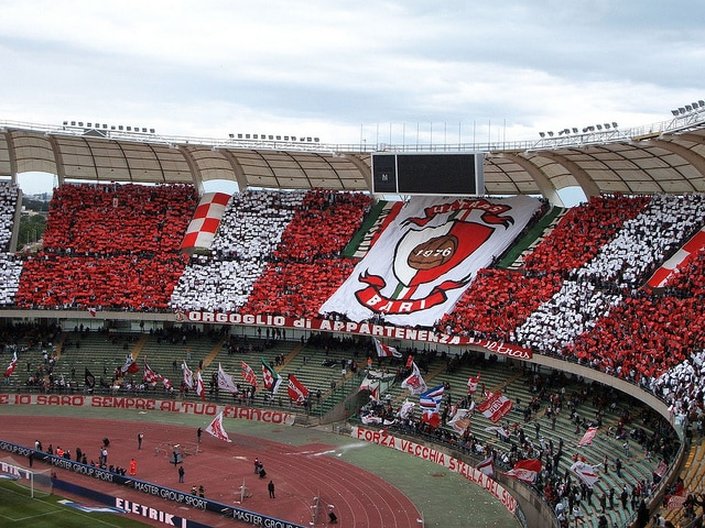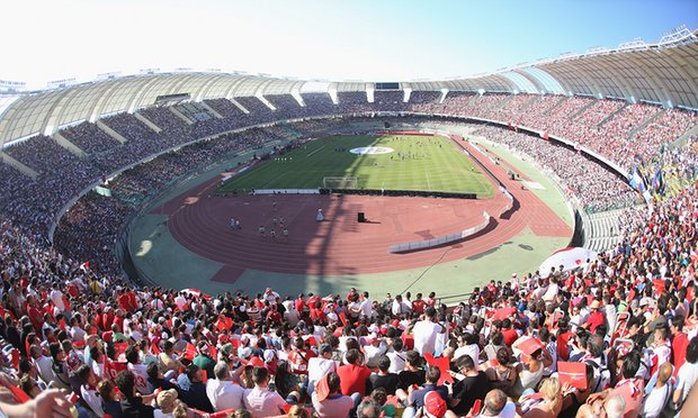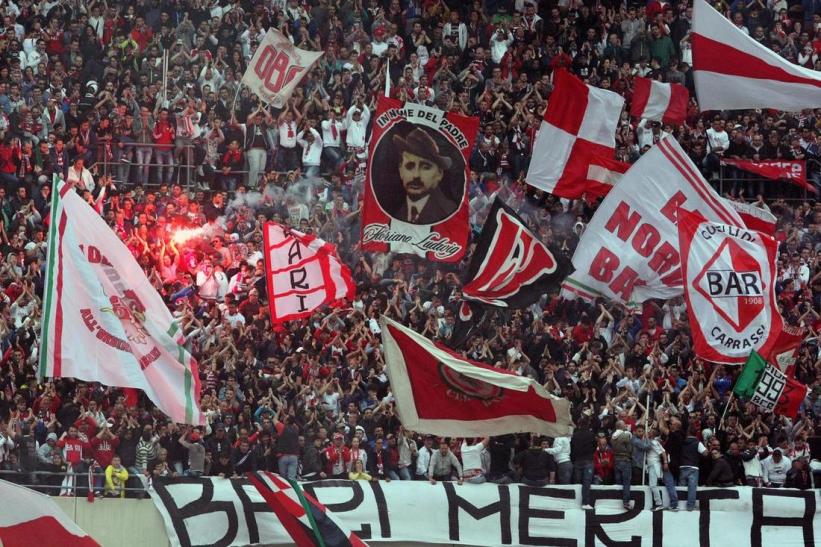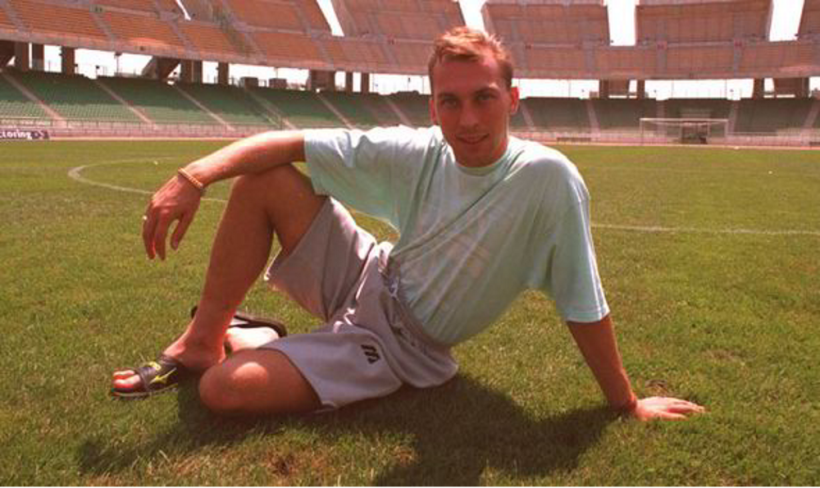Stadium: Stadio San Nicola, capacity 58,270
The Stadio San Nicola nicknamed ‘The Spaceship’, does not live up to this futuristic title. Rather than a state of the art modern football ground, as the tag suggests, it is in fact an impressive yet run down structure with a bizarre and brief history.
It resembles an ex-Russian fighter jet that has been left in the junk yard after the cold war and has not seen little love or attention in a while, yet at a push, is still operable. The sad fact of the matter is that from the outset, this superb structure, was the victim of poor planning and circumstance right from its conception.
Whilst Bari may have the South of Italy’s second largest economy there has been little need for a stadium of this size to be constructed there. The 1990 World Cup came to Italy and changed all of this, as whilst ten of the existing stadiums could be modernised, there were still two more that needed to be built. The legacy of both is arguably as disaster, although the methodology for the one in Turin made sense. The Stadio Deli Alpi was constructed not only for the World Cup but also to house Juventus (Italy’s biggest teams) and Torino (one of the oldest and most established). Despite this the old Deli Alpi has been now pulled down and replaced by the modern Juventus Arena.
As the bricks were being laid on the North of Italy, construction started in the South also and whilst Bari were certainly no power house of Italian football, the stadium was needed it was thought and at the time it seemed ‘the bigger the better.’ Whilst even with hindsight it is hard to argue the logic of this construction, it was and still is a good looking structure.
Designed by Renzo Piano, it has a ring of 26 concrete ‘petals’ that go all the way around the top tier and the lower tier is set in a depression next to a running track. At the time the stadium was state of the art and its security features (Quick access and exit) were to be applauded but like many of the Italia 90 stadiums these were quickly outdated after the Taylor report in the UK set a precedent of the ‘new modern ground’.
One thing that cannot be taken away from the ‘Spaceship’ and that is that for a short time in the early 1990’s it looked like a super structure was the future of modern stadia. Finished just in time for Italia 90, it hosted games in Group B featuring the fantastic Cameroon, the poor quality Soviet Union side and the Romanians. The crowds in Bari were then treated to a Czechoslovakia side featuring the prolific Tomas Skuhravy who single handily destroyed Costa Rica. The final game of the tournament was the third place play off between the dejected England and Italy teams. This match saw Salvatore Schillaci net his sixth or the tournament whilst David Platt was on the score sheet for England, a name the fans would soon become accustomed to.
Sadly, despite some good crowds in Serie A in the following seasons the final hurrah on a world stage was in 1991 when it hosted the European Cup final won by Red Star Belgrade against Marseille. The Yugoslavians won the game on penalties in what was at the time, one of the best arenas on the continent.
The gradual decline of the ground heightened as Bari slipped out of Serie A soon in the 2000’s they were playing in front of an average of 5,000 fans. The team have reached the play-offs for Serie A again (at the time of writing) and this campaign has seen ground slowly see an increase in spectators whilst there have been some memorable scenes by the Ultras. These spectacular visual displays have been a nostalgic reminder of what could have been and in the 2015-16 season the team averaged a total of 21,476 for the year. This increase of 11.4% has been seen throughout the lower leagues and Bari finished top in Serie B for spectators.
There is a long way to go to see if the team will ever bring crowds to the stadium as they did in that brief spell in the 90’s and perhaps they never will. Should the club manage to modernise the ground and the team secure her place in Italy’s top flight then who knows? The space ship is as it stands a sad reminder of poor planning and unfortunate circumstance but the Ultras and local fans are just about keeping the heart beating of this gorgeous yet ridiculous stadium.
The Ultras

The walls of the futuristic Stadio San Nicola shuddered. Inside, the scene was one of exultant pandemonium. The stadium they call the spaceship had lift-off and the man igniting its engines was a baby-faced Antonio Cassano. As he celebrated under the Curva Nord, flares were lit, flags were waved frantically and the decibel levels soared. Cassano was quickly smothered by the embraces of a jubilant mob. When he emerged from the morass, this 17-year-old boy was no longer just a prodigious talent, he was a Bari icon: the local boy who had felled a Milanese giant.
The game in question was one that Bari fans still remember fondly, a famous 2-1 victory over Inter on a rain sodden night in December 1999. Led by legendary Italian coach, Marcello Lippi, this Inter side boasted the defensive steel of Laurent Blanc and Javier Zanetti, while Ivan Zamorano and Christian Vieri led a talent laden attack. However, it was the boy from Bari who stole the show, scoring a virtuoso goal which included the deftest first time control you are likely to see by a man running in full flow. It was the type of goal that will forever occupy the memories of those who witnessed it, one of those goals that continues to make spines tingle, even for those watching on YouTube.
Giancaspro, a life-long Bari supporter who has travelled the length and breadth of the peninsula following the Biancorossi (Red and Whites), was there to witness Cassano’s famous goal. For him, it was a game made all the more special by Bari’s feverish support, who have continued to follow their club through thick and thin. In fact, despite spending only six of the last 20 seasons in Serie A, Bari remain one of the best followed clubs in Italy and their average attendance over the last two seasons has been the highest in Serie B, also putting them in the top half of Serie A attendances. Even when Bari were on the brink of financial implosion in 2014, their stalwart support rallied around them, turning up to the San Nicola en masse (setting a record for the highest Serie B attendance against Latina) and even helping to fund the team’s travel to away games.
Luca spoke to Giancaspro to find out more about Bari’s fanatical supporters, a discussion which also included a special mention for Bari’s English Maradona – David Platt.
Bari’s organised support have had a long history; can you tell us a little more?
The Bari supporters formed their first group in 1976, led by Franco Marvulli, nicknamed ‘Florio’. They united under a banner that read ‘Alè Grande Bari Club Ultras’. During the same season, positive results on the field helped Bari earn promotion to Serie B and following the example of many other Italian cities, Bari’s organised support was created.
It became a real point of reference and identity for thousands of youngsters with one passion in common: their unconditional love for A.S Bari. Florio ensured the group positioned themselves in the Curva Nord, following in the footsteps of Torino’s Curva Maratona, for which Florio had great admiration. Soon after, a new banner appeared in the Curva Nord, its design more professional, on which the writing read ULTRAS accompanied by a symbol of a skull profile above two crossbones.
By the side of Florio were two other renowned capi [leaders] of the Curva: Claudio ‘Maza’ and Maffei. In the early 1980s, different relationships were formed between the ultras Bari and other organised fan groups: twinnings and rivalries. Groups from Lecce, Taranto and Foggia became Bari’s biggest rivals, while a long and steady friendship was born with the ‘Eagles Supporters Lazio’. During that same period, new and important characters came into the picture and reshaped the ultras movement: Leo Volpicella, Maurizio Fedele and the two youngest Ciccio Lepore from the Gioventù [Young Ultras] and Alberto ‘Parigino’.
In 1983, Bari were relegated to Serie C once again and for the first time, the supporters unveiled the banner with a winged skull facing frontwards, one which is still in use today. During these years, the U.C.N [Ultras Curva Nord] played a key role in events that had both positive, but also above all negative consequences: on the one hand, the first striped [red and white] choreography was produced (Bari-Monza 1982-82), and hundreds of passionate fans followed the team on the road like never before. On the downside, one cannot forget the [violent] incidents at Siena in 1983 and Pescara in 1984.
Why did the Ultras Curva Nord (U.C.N) disband in 2012 and which groups have replaced them?
They disbanded because of the Calcio Scommesse (Football Bet) scandal in which some of the Capi Ultra were guilty of threating the players in an attempt to make them throw games. Now, there are new groups, such as the ‘Seguaci della Nord (Followers of the North), into which former groups such as ‘I RE’ DAVID’ (King David) and ‘BULLDOG’ have converged.
For you, what moments have been the most memorable, not only for the team but also the fans?
We’ve enjoyed many great moments. I remember the Bari of Eugenio Fascetti [coach from 1995-2001 who managed Bari for three consecutive seasons in Serie A), the Bari of coach Antonio Conte [who won the Serie B title in 2008], the Bari of Giampiero Ventura [who guided Bari to a tenth place finish during the 2009-10 season]. But also earlier we had great teams like the Bari of mister Enrico Catuzzi [who rose through the coaching ranks to take charge of Bari in Serie B and C from 1981- 83], mister Materazzi [who earned Bari promotion to Serie A between 1993-95] and Gaetano Salvemini [who won promotion with Bari during the 1988-89 season and would eventually bring in Englishman David Platt]. Let’s just say it’s been a rollercoaster.
On the subject of David Platt, he was and remains a popular player in England. Can you tell me something about his time at Bari? How did the fans view him?
Platt was at Bari when I was young and I don’t remember that period as well. However, I have seen many images, and have been told many stories recalling Platt’s success at Bari, including his famous press conference in which he proclaimed he wanted to become the Maradona of Bari! He was part of a very strong and special team. As a player he left his mark and was a joy to watch.
From one iconic ex-Bari player to another, Antonio Cassano was born and bred in the city and grew up in the youth team however it does not look like he will return. What does he represent for the club and fans?
Antonio was our most important player, even though many fans don’t hold him in the same esteem after his comments regarding his love for Sampdoria. But I think that he has always had Bari in his heart, even if he doesn’t say so in interviews. He is tied to Samp because of his wife [who is from Genova] but his roots are here in Bari.
In 2014, Cassano was vocal in his support for Bari during their financial problems, what was the fans role during this period?
In 2014, the fans played a crucial role in pushing the club from low to high. It was a memorable effort that did not result in Serie A promotion but made us very proud of the boys who simply played for our happiness and for our shirt and these are values that we as fans appreciate the most. The players gave their best for the club, which was not the case for the players who followed them and thus they did not earn the same affection.
Let’s talk about what can often be a controversial subject, politics and Calcio. What do you think about manifestations of politics in Italian stadia?
Today politics is on the decline in the stadia. However, it has not disappeared. At Bari for example, there is controversy within the ranks of the ultras as to whether the colour of the shirts they wear should be black or red… [a metaphor for the struggle between small left-leaning and right-leaning political factions within the support].
Local pride or ‘campanilismo’ is often very prominent across Italy, is pride of hailing from Puglia important among Bari fans?
Very much so, you really feel the pride, especially among Bari supporters who live in the north of Italy. When there are away games in the north, we always meet up with them and they tell us that they are always watching the games, eating traditional food sent from Bari. It’s great fun seeing each other, we are in love and I am one of those fans who lives and breathes Bari. I really suffer when we lose, I lock myself away and feel ill.
Given that clubs from northern Italy have traditionally been more successful, does the fact that Bari are one of the biggest teams in the south mean they are regarded as a symbol of southern Calcio?
Yes yes, absolutely! But, as in all of Italy, other clubs don’t see it that way and our local rivalries are very bitter, such as our hate for Lecce, Taranto and Foggia. On the other hand, there are also positive twinnings between Bari, Salerno and Reggio [Calabria].
What are your thoughts of the Italian ultras movement of today?
I’m not an ULTRAS any longer, I am just a fan. I still admire them [the ultras] for their dedication, commitment and organised tifo. But I do not agree with the ‘mentalità ULTRAS.
There is often a sense that the ultras movement can be a negative phenomenon, what are is your opinion?
Yes, you are absolutely right and this is exactly what I meant before when I spoke about the ‘mentalità ULTRAS’. The consequence of what the fans did at the Pescara-Bari match [in 1984], destroying bars and rioting with the police meant the lega [football federation] prevented real fans from travelling to the following away games.
What do you think of English fandom and what is the difference between English fans and Italian ultras?
There is a chasm between English and Italian fans. When it comes to mentality and structural organisation within the stadia, we are lagging well behind. This is mainly due to the decrepit state of the Stadia. The government don’t give a damn and there are Stadia in Serie B that are not fit for purpose because they are old and the local authorities don’t have the money. However, the wind appears to be changing, look at Juve and Udinese who now own their new Stadia.
For you, what is the most important aspect of Italian fandom?
To be incredibly and absurdly passionate. We are very organised, especially for our trips during away games. We live football 24 hours-a-day.
It appears that Bari are well respected within the landscape of Italian football; can you explain why?
Easy, because we have a beautiful stadium, we are beautiful fans and the club has produced the best players [including Antonio Cassano, Gianluca Zambrotta and Leonardo Bonucci], sporting directors and nationally famous coaches.
What’s your verdict on this season? You are in a good position to make the play-offs; it would be great to see Bari back in Serie A!
We’ve had highs and lows but it appears the boys have more belief now and this has shown as the season has gone on. We have a great team this year and I think if they players had worked harder from the beginning of the season; we could have made automatic promotion.
Finally, for our readers, can you explain what it means to be a Bari supporter?
For us, Bari is our life, it means everything. Bari is our passion. We cry, we argue and celebrate for our colours and the badge. I definitely live these emotions and I always wear the shirt, even when I travel abroad or when I go up north because I am lovesick for Bari, like so many others who support the Biancorossi.
Grazie Giancaspro for all your insight and help. Good luck and Forza Bari!
Classic Player: David Platt
“If I hadn’t scored that goal, I might still have ended up playing in Italy but, realistically, I’m sure it was the catalyst.” David Platt on the importance of his extra time goal against Belgium in the last 16 of Italia ‘90’.
The men who exhibited their talents in the most spectacular fashion whilst in the then modern stadiums of Italia 90, often found themselves in Serie A the season afterwards. Many like Marco Van Basten, Careca, Diego Maradona and Lothar Matthaus to name a few, were already there but there was certainly a second influx. This second group of men who had stared in the tournament did not all find themselves at Juventus, Milan and Inter. They enhanced the league by filling the ranks of the smaller clubs. Tomas Skuhravy arrived in Genoa, Oleksiy Mykhaylychenko moved to Sampdoria at the same time and Bari signed an Englishman by the name of David Platt.
Bari had only been promoted in 1989 but had two things in their favour. Firstly, they were owned by Vincenzo Mataresse who was the son of a construction mogul, Salvatore Mataresse and they had been the fortunate benefactors of the ‘Spaceship’ Stadio San Nicola thanks to the World Cup. Now it was time to spend some money and recruit some foreign stars to supplement their fledgling Italian team.
By the start of the 1991/92 season the Biancorossi had their foreign imports in place. Brazilian Joao Paulo was a striker brought in in 1989 who was creative but far from prolific. Two Yugoslavians had been brought in and were unknown at the time, Robert Jarni has arrived from Hajduk Split whilst Zvonimir Boban was on loan from Milan. Finally, Australian Frank Farina had been brought in in midfield from Club Brugges with David Platt up front, it was not the first time Bari had an Englishman in their ranks as Paul Rideout had played 99 times scoring 23 goals between 1985 and 1989.
Platt inadvertently set the bar very high in the South of Italy, not only for himself but for the club. He has been wanting a move to a bigger club but he was clever enough to recognise that a £5.5m move to what was at the time, the world’s best league would put him straight into the shop window.
Perhaps it was the fact he had moved to a smaller club or perhaps he was just that confident but his opening press conference was of Zlatan-esque proportions when he stated that he wanted to be the ‘Maradona of Bari’. This was an exceptional claim considering the stature Maradona at the time and whilst it was met with an out pouring of joy from the home fans, it was almost impossible that he would signal handily win them the Scudetto.
Despite this, he was given the number 10 shirt, made captain and allowed to thrive in a Trequartista role. Though not a position many would associate with Platt, and whilst we don’t see this position utilised as much now due to the speed of the modern game, the Englishman did possess good spacial awareness, good technique, could spot a beautiful pass and what’s more, he could score goals. Many may argue that he was more adept as a No.9, and his finishing during his season at Bari certainly supported this. In 30 appearances at the club, he scored 11 goals and despite the team being relegated, he became a cult figure, especially as Bari themselves only scored 26 all season.
Perhaps the most enduring image of Platt at Bari was the Englishman stood over the ball on the penalty spot at the San Nicola. He was incredibly deadly from set pieces and was predatory in the box; one only needs to look at his brace against Roma that year to get a flavour of his abilities.
These exploits soon turned the heads of Juventus who decided to rescue Platt from the prospects of plying his trade in Serie B. It was a huge move for the man from Crewe, and one that ultimately saw his dream of playing for a big club come true. It was a shame that the Bari-Platt romance could not have continued longer, but the memories remain. When Calcio ruled the world, David Platt was ‘that’ Englishman in San Nicola.



